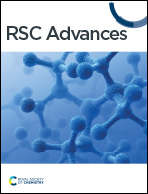Preparation of nickel foam modified by multiwalled hollow spheres of NiCo2O4 as a promising non-enzymatic glucose sensor†
Abstract
Nickel foam modified by hollow sphere NiCo2O4 particles was successfully prepared via a hydrothermal method using nanosphere SiO2 particles as the hard template for the hollow structure. Characterisation using SEM-EDX and TEM confirmed the structure as multiwalled hollow spheres with an average size of 270 nm, while characterisation using SEM, XRD, and XPS confirmed that the NiCo2O4 particles were attached on the surface of the nickel foam. BET analysis showed that the surface area of the synthesized NiCo2O4@Ni foam was nearly three times higher compared to that of the unmodified Ni foam. Investigation of the NiCo2O4-modified nickel foam as an electrode for the detection of glucose in sodium hydroxide solution showed high linearity of the anodic currents (R2 = 0.99) in the concentration range of 0–2.5 μM with sensitivity of 0.060 mA μM−1 and an estimated limit of detection of 0.060 μM. Excellent stability of the current response was also obtained with a relative standard deviation of 1.51% (n = 10). Furthermore, the developed sensor demonstrates strong applicability for glucose detection in real samples of human blood plasma, making it highly suitable for practical use. The results indicate that the material is promising for the further development of nickel-based sensors.



 Please wait while we load your content...
Please wait while we load your content...